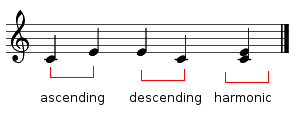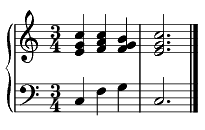Ear training is an integral component of our musical studies. In ear training we are developing our inner ear, the ability to accurately hear and identify musical elements in our head while reading, listening to, and thinking about music. Conservatories, colleges and universities usually require students to take ear training courses as part of their music programs.
Some musicians develop what is called perfect pitch: the ability to accurately hear and identify pitches by name instantaneously. This skill seems to develop naturally especially with piano and string players who start their practice around the age of five or six, but for students that start music later in life, perfect pitch is an extremely difficult skill to learn.
Instead, most musicians develop their relative pitch. Relative pitch is our ability to discern the relative distance between notes, as well as the quality of different types of musical elements like scales and chords. Any music student can train their relative pitch. In fact, anyone who listens to music and can hear the difference between higher and lower notes, has relative pitch – that is to say, everyone.

Can you hear the difference?
If you wanted to get started training your relative pitch, a powerful but simple technique is to simply start singing back what you hear. You can try it with the musical example above, as well as the ones that follow.
The study of ear training is usually divided into several different categories which are similar to the ones we study in music rudiments: intervals, scale types, triads, seventh chords, harmonic dictation, and melodic dictation. We also consider sight singing as an element of ear training.
Categories of ear training
Intervals
The first aural skill that a student usually works on is interval recognition. A musical interval is the distance between any two pitches. Intervals have both a size and quality, for example, a major third. The student works on recognizing both ascending and descending melodic intervals, as well as harmonic intervals, the simultaneous sounding of two notes, as in the following example:

Interval Examples – Ascending, Descending, and Harmonic
Scales
Students also learn to sing and recognize different scale types. For classical musicians, we start with major scales and the different forms of minor scales. In the example that follows, you probably will be able to hear the difference in the quality between the C major and C minor scale even though they start on the same pitch:

Scale examples – major and minor
Triads
Triads are the basic buiding blocks for chords in western music. There are four basic triad types: major, minor, diminished, and augmented, presented below, here all built on the pitch C. We construct triads by stacking three pitches in thirds on a root note: C to E, for example, is a third: count C-D-E, one-two-three. Similarly E to G is a third. Each of the triads you will hear below contain Cs Es and Gs. We create the different triad types by adjusting the Es and Gs with sharps and flats. More importantly, notice that it is really not that difficult to hear that these four triads have different qualities:

Examples of Triads – Major, Minor, Diminished, Augmented
Seventh Chords
We can extend our ability to recognize different triads to include various seventh chords. Seventh chords add an extra third onto the basic triad. In classical music, there are five basic seventh chord types: minor sevenths, major sevenths, dominant sevenths, half-diminished sevenths, and diminished seventh chords. To identify and produce these chords, we need to have an understanding of triads and intervals. Nevertheless we can learn to hear their individual qualities:

Examples of Seventh Chords
Chord Progressions
In western music, chords are connected together to create larger musical structures, called chord progressions. These chord progressions give music a sense of direction: moving from a beginning harmony, to a point of musical tension, and its release, returning back to the opening harmony. We can learn to recognize these progressions and patterns. Below is a common chord progression in C major that is the basis for a lot of classical music. We can easily hear that it has a starting place, develops harmonic tension as it move to the second last chord, and the resolution of this chord to a place of rest in the final harmony:

Example of a chord progression
Melodic Dictation
Just as we can learn to recognize intevals, chord qualities, and chord progressions, we can learn to reproduce melodies that we hear, either at our instrument or even writing them down. We use our knowledge of these different musical elements, as well as our experience of what we would expect to happen to do so. Listen to the following scale:

Can you complete this musical phrase?
It’s not hard to hear that the last note creates melodic tension and an expectation: the scale is not finished. I bet you could sing the final note.
Sight Singing
Sight singing is the skill to produce all of the above musical elements with your voice. In fact, sight singing is an important tool to use in developing your inner ear. Take that major scale above as an example. With a little practice, you will be able to sing and recognize its quality as representing all major scales. With careful study, singing scales, intervals and triads teaches you how to recognize these different musical elements. You can then learn to accurately sing and hear a written melody at sight in your head, what an amazingly useful skill for a musician to have.
The importance of ear training
The study and practice of ear training develops our musicianship. We begin to build an active understanding of the music we listen to and produce. We can learn new music faster as we start to recognize and anticipate its different elements. If we are interested in writing music, the more sophisticated our understanding of musical sounds, the easier it is to translate our ideas to the score.
Training our relative pitch takes time and patience. It tends to develop as our other musical skills develop. A long term project for sure, but a very rewarding one.
This is the first post in our new series on pitch and harmony. We’ll take you step-by-step from the basics through to some advanced scales, chords and harmonies, with plenty of examples and exercises for you to work on. Any questions? Speak your mind below!









THank you.
I really appreciate the prose in these articles! It is uncomplicated and takes care to introduce musical terms with clarity. Nicely done!
I hav e studied this subject a little. So I can follow the reasoning. It is challenging. But I appreciate your Can Do approach!
Thanks for the feedback – Keep up the good work, Melissa!